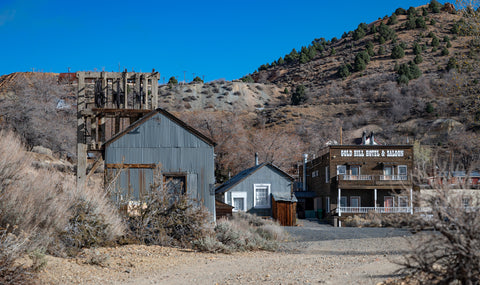
Not Even the Tragic 1869 Yellow Jacket Mine Fire Could Kill Gold Hill, Nevada
Most Western mining camps marked distinct beginnings and endings based on the initial discovery of precious metals and the end of mining activities. Such towns sprang into being, boomed with profitability and then faded away when the costs of extracting the metal from the porphyry exceeded the return. Gold Hill also faced the challenge of its location in a deep and precipitous canyon given to flooding. Indeed, its very discovery in January 1859 was driven by men who journeyed to the head of Gold Canyon in response to snowmelt from warm weather. They followed a rivulet north up the ravine to discover a huge quartz outcrop streaked with gold. It resembled a veritable hill of gold, hence the name of the town that rose up beneath it.
The very channel of the ravine that led men to its riches became the main business street through town. Within months of the discovery Gold Hill comprised a scattering of log houses and one large log boardinghouse inhabited by a few hardy miners scraping out $20 a day. Placer miners would exploit the shimmering hillock for three years before realizing it was an extension of the Comstock Lode and that silver ore was thus more plentiful and profitable than the gold.
It was in June 1859 that miners discovered the seemingly inexhaustible silver deposits of the Comstock, a mile north of Gold Hill, thrusting the entire region into prominence. Though destined to toil in the shadow of Virginia City—the town the Comstock birthed and Nevada’s largest metropolis through century’s end—the residents of Gold Hill could still crow about its age. It was five months older than Virginia City and boasted the territory’s oldest mill (erected in 1860), as well as some of the oldest foundries and factories supplying machinery for the mines and mills. As its mines developed, the population grew, and hard rock mining replaced the placer claims. Such productive mines as the Yellow Jacket, Crown Point, Kentuck, Belcher, Justice, Imperial and Empire duly garnered headlines nationwide. By 1864 nine boardinghouses lined Gold Hill’s steep streets, and the population peaked in 1875 at roughly 8,000 souls.
The 1880s headframe of the Yellow Jacket rises
tomblike atop the site of the horrific 1869 fire that claimed several dozen
men.
Blacksmith V.A. Houseworth, the first so-called recorder in Gold Hill, kept his tattered book of records behind the bar of a local saloon, the miners recording their own claims as they saw fit. The original June 1859 location notice of the Yellow Jacket mine claimed 1,200 feet of a vein, including all its depths and spurs—“depths and spurs” meaning the miners intended to follow the vein of precious metal wherever it led, regardless of how complicated or conflicted it became with other claims. One historian estimated that more money was made by Comstock lawyers trying to settle poorly recorded claims than was generated by the mines themselves.
One enduring local rags-to-riches-to-rags love story centered on Alison “Eilley” Oram Bowers and her younger, handsome husband, Sandy. Eilley ran one of the first boardinghouses in town, and Sandy was one of her longtime boarders. Their love grew as his wealth from the mine bearing his surname mushroomed. The two soon built a magnificent home in the Washoe Valley, today preserved as a museum within a regional park. Sadly, their lavish lifestyle ended when Sandy fell ill and died at age 35. Bankrupted soon after, Eilley resorted to telling fortunes and prognosticating under the alias of “The Famous Washoe Seeress,” though apparently she didn’t foresee her own eventual impoverishment and death.
Gold Hill enjoyed solid, steady growth through the 1860s. By 1864 residents had erected a Town Hall, with police court and jail, opposite the popular Vesey House. The oldest operating hotel in Nevada, it welcomes visitors today as the Gold Hill Hotel. Virginia & Truckee Railroad tourist trains make occasional stops at the restored depot.
The
Virginia & Truckee tourist train approaches the depot. At last count in 2005
Gold Hill’s population was 191.
In 1867 the Gold Hill Daily News estimated that a stunning $85 million ($1.8 billion in today’s dollars) had been extracted to date from the state’s mines. Seven years later the aggregate value of the Virginia City and Gold Hill mines topped $93 million (nearly $2 billion in today’s dollars). But all that wealth came at a steep cost. In the early morning hours of April 7, 1869, a fire broke out in the Yellow Jacket. It soon spread to the Crown Point and Kentuck, claiming the lives of at least 35 men (perhaps as many as 45) in one of the worst mining disasters in American history. The day shift began work at 7 a.m., and dozens of men were lowered into the mine before the fire was discovered. Families gathered at the surface in despair to wait inconsolably for lost husbands, brothers and sons. At the time the popular dramatic actress Amy Stone was playing Piper’s Opera House in Virginia City, and she promptly hosted benefit concerts for the families of the deceased Gold Hill miners.
Gold Hill’s most famous resident may have been author Mark Twain, who lived in a local boardinghouse sometime in 1863. A co-worker from Twain’s days at Virginia City’s Territorial Enterprise recalled their having roomed together in Gold Hill. But traditional hard-rock mining ended in the late 1880s, and the Gold Hill of Twain’s memory is long gone, having faded with the long-ago shriek of steam whistles and thunderous bellow of machinery.
